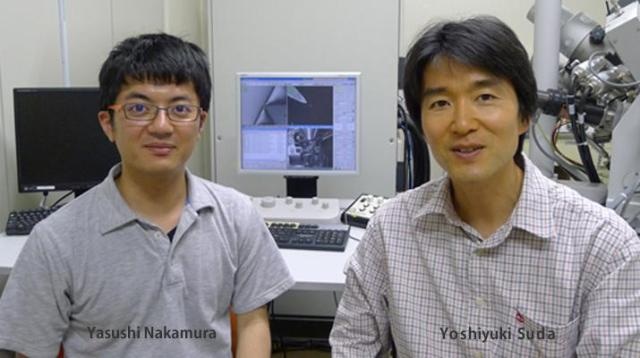May 18 2016
Carbon nanocoils, also known as CNCs, are a rich class of low-dimensional nanocarbons, with a helical form making them appropriate for various applications like microwave absorbers and several mechanical parts like springs.
 Master's course student (graduated in March 2016) Yasushi Nakamura (left) and Associate Professor Yoshiyuki Suda (right). (Credit- Toyohashi University of Technology).
Master's course student (graduated in March 2016) Yasushi Nakamura (left) and Associate Professor Yoshiyuki Suda (right). (Credit- Toyohashi University of Technology).
The usual coil diameters and thicknesses of carbon nanocoils are within the ranges of 100 to 400 nm and 400 to 1000 nm, respectively, and their entire lengths are much bigger - in the range of several tens of µm. Despite initial pioneering work, the relation between the natural CNCs geometric shape and their electrical and mechanical properties, especially the electrical resistivity, are not properly understood.
Now, scientists at Toyohashi Tech, University of Yamanashi, National Institute of Technology, Gifu College, and Tokai Carbon Co., have proven that as the coil diameter increases, the resistivity of CNCs also increases. This called for the improvement of an exact resistivity measurement technique, making use of a focused ion beam (FIB) and nanomanipulator procedure to choose a sample CNC with the required coil geometry, and subsequently make strong electrical connections to the electrodes of the instrument. All the resistivity statistics acquired using CNCs were precisely fitted by a curve expected by a theory called variable range-hopping (VRH), which is appropriate at low temperatures for disordered materials.
The research proves that the nanocoil’s interior comprises a material that changes its electrical properties. The researchers observed 15 distinct CNCs, and three CNCs that had been graphitized artificially to provide lower resistivity (G-CNCs). Even though the CNCs resistivity improved with the coil diameter, it was nearly unaffected for the G-CNCs. As a result, for the CNCs with the highest diameters, the resistivity was nearly of a magnitude twice larger than the graphitized forms. This large inconsistency in the resistivity among CNCs and G-CNCs suggests a noteworthy structural intricacy within the CNCs.
The results indicate that the inner side of CNCs with huge coil diameter is occupied by a highly-disorderly carbon network that contains many small regions (called sp2 domains) implanted in an ocean of amorphous carbon. To check this theory, the temperature reliance of the resistivity between 4 and 280 K was studied. The resistivity data followed two diverse versions of the VRH theory; the Mott-VRH version in the temperature range of 50-280 K, and the Efros-Shklovskii-VRH version in the range of 4-20 K. Remarkably, as the coil diameter was altered, the resistivity curves moved smoothly between regimes.
We found this behavior three years ago. Owing to the efforts of two students, we included the resistivity data for G-CNCs and straight carbon nanofibers (CNFs), and compared them to the data for the CNCs. I am so glad that Prof. Hiroyuki Shima and Dr. Tamio Iida joined this study. We obtained the low-temperature measurement data and discussed it using the VRH theory. Eventually, we came to the conclusion that this behavior is a unique phenomenon for CNCs and can be fitted by VRH.
Yoshiyuki Suda, Associate Professor, Toyohashi Tech
Yasushi Nakamura, the first author, a Master's course student remarked about how they went past the CNC resistivity measurements of the other teams. "It was a long and challenging task. I had to prepare many single CNC samples using a focused ion-beam apparatus. Our finding was achieved by establishing a precise measurement system using a scanning electron microscope and acquiring resistivity data for many single CNCs."
The current results on resistivity qualitatively agree with the earlier discoveries on the CNCs’ mechanical properties: Tensile load trials demonstrated that their shear modulus rises with the diameter of coil. The positive connection between the coil diameter and shear modulus is probably caused because in large-diameter CNCs, the population of sp2 domains that are brittle against shear stress, is lessened when compared to small-diameter CNCs.
These results indicate that with regard to nanocoils, the resistance and inductance are well-defined by geometric factors. Especially, coil diameter, length, and pitch are significant. The new found association can be utilized to enhance control over the peak frequency of electromagnetic wave absorption, where depending on the impedance properties; a specific range of frequencies (~GHz) is absorbed.
These conclusions hold potential for developing CNC-based nanodevices, spanning from nano-solenoids and extra-sensitive mechanical springs to electromagnetic wave absorbers.